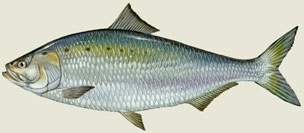| New Jersey Division of Fish and Wildlife |
As Spring gets a firm hold on the landscape, the thoughts of many turn to the Delaware and the annual migration of spawning American Shad. Anglers may wonder how the drought conditions affecting the region, with its impact on stream and river flows, will influence this year's run. While predicting the behavior of any wild species is inexact, a look at present conditions and last year's run can provide an idea of what to expect.
 The combination of low water and warm temperatures seem to be pointing towards an earlier than usual American shad run in the Delaware River this year. By late March there have been some reported catches in the warm water effluent of the power plant in Trenton. The mainstem Delaware River water temperature is above 45 degrees and rising. With virtually no snow melt to further cool the water, and continuing warm days, the run should be underway. As far as last year…
The combination of low water and warm temperatures seem to be pointing towards an earlier than usual American shad run in the Delaware River this year. By late March there have been some reported catches in the warm water effluent of the power plant in Trenton. The mainstem Delaware River water temperature is above 45 degrees and rising. With virtually no snow melt to further cool the water, and continuing warm days, the run should be underway. As far as last year…
Sampling for the 2001 American Shad Spawning Run began on March 23 and continued through May 31. Using the hydroacoustic technique of echo integration, American shad upstream passage in the Delaware River at Lambertville, NJ was monitored from the Interstate 202 Toll Bridge piers.
American shad schools were visually distinguished from other large fish targets by their distinct echo pattern, school size and unique behavioral characteristics at the site. Shad passage was the highest on April 16, 23 and 26 when approximately 62% of the 2001 upstream American shad run passed the toll bridge during just these three days. Shad passage was greatest in bridge span 5, which is on the New Jersey side of the river. Approximately 39% of the 2001 shad run passed the toll bridge using span 5. Shad passage was the highest in the daylight hours between 9:00 am and 2:00 pm with peaks at 10:00 am and 12:00 noon - 1:00pm. Shad passage was low during darkness periods.
Delaware River discharge was slightly below normal (relative to historical flow data) from March 27 to 29 and from April 4 to 7, and it was well below average from the last week of April through the third week in May last year. Discharge was above normal during the first few days of sampling from March 31 to April 2 and from April 9 to April 16, with peaks on April 1 and April 11. Shad passage was generally greatest during periods of reduced flows.
Total American shad passage at Lambertville during the 70 - day monitoring period was estimated to be 417,300 fish which compares well with past hydroacoustic estimates as it is the second highest number recorded for the seven years that this technique has been employed.
Haul seining for the juvenile shad produced from the 2000 spawning run averaged 276 shad per seining. This is the sixth highest on record, above the 22 year average of 217, and barring any unforeseen circumstances should result in a good spawning run when they return as adults.
The best way to determine how the shad run shapes up is to get out and spend some time on the river. Anglers interested in current conditions can check the Shad Hotline at 610-954-0577 or 610-954-0578. This Website also carries reports from the Delaware River.
Image by Duane Raver / USFWS